The Alabama Supreme Court’s recent and right decision to deem embryos created through in vitro fertilization (IVF) as people sparked concern from fertility facilities regarding the future of IVF. This concern resulted in Alabama rushing to pass legislation to preserve IVF, with a push from President Trump urging Alabama to “act quickly to find an immediate solution.” This bill, signed by Republican Gov. Kay Ivey, grants immunity from legal consequences to those providing and receiving services if embryos are damaged or destroyed during the procedure. Despite this legislation, there are still fears surrounding the future of IVF.
Since Alabama claimed that the accidental death of three couples’ frozen embryos qualified under the Wrongful Death of a Minor Act, physicians have been “…worried that officials might cap the number of embryos that can be created in each treatment cycle, which often entails the fertilization of several eggs, [and that] lawmakers could also ban the freezing of backup embryos, which … would result in less efficient and more expensive treatments.” There are also concerns about further limitations on embryonic research.
Eliminating ‘Defective’ Children
What these concerns have in common is that this ruling forces society to rise above past eugenic practices that we are, apparently, not ready to abandon. If states further enforced restrictions on IVF, embryos would no longer be non-person, commodifiable objects society can do with as it pleases, as was prevalent in Greek and Roman cultures long before the term “eugenics” was invented and widely practiced across the globe.
The IVF process often involves the preimplantation screening of blastocysts (early embryos) to determine the likelihood of implantation success and test for genetic defects. Those considered “non-viable” are discarded. This eugenic practice opens the door to the elimination of “defective” children, as those utilizing preimplantation screenings with the hope of producing only perfectly healthy children may be more inclined to choose selective reduction as well.
Selective reduction (abortion) commences with the injection of potassium chloride into the heart of the unlucky fetus, which stops the small heart from beating. In instances where babies share the same amniotic sac, more inhumane techniques are used such as bipolar cord coagulation and radiofrequency ablation, which cut off umbilical cord supply, thus starving the baby of oxygen and nutrients. In ancient Rome, this dehumanization of children can be described by a quote from the philosopher Seneca in the first century CE: “…unnatural progeny we destroy; we drown even children who at birth are weakly and abnormal.”
Similarly, in ancient Greece, abortion was encouraged to limit the number of children in families, as was infanticide for babies born with deformities. The Spartan society highly valued marriages that would strengthen the genetic excellence of the population, and therefore partners were selected based on traits such as physical fitness. The government would even intervene and arrange marriages or force divorces if the couples were judged unfit for each other and thereby incapable of producing strong offspring.
The Build-a-Child Mindset
How does the IVF process encourage this type of “selective breeding”? Well, besides selective reduction, reproductive technologies such as IVF often include gamete donation. With gamete donation, people can choose from a catalog of donors and pick certain physical and intellectual characteristics. Gamete donors must meet certain requirements, such as certain physical and intellectual characteristics, a certain ethnicity, a certain height, “good genes,” physical attractiveness, and good health to weed out any “undesirable” traits.
The IVF process often involves the eugenic practice of creating designer babies based on intelligence, hair color, eye color, etc., through gamete donation. Dave Rubin compared the process of picking an egg donor to being “like Tinder,” and went through the site searching for a physically healthy donor who didn’t have major genetic issues and “sort of looked like the type of girl they might be with,” showing the build-a-child manufacturing mindset involved in the gamete donor process that diminishes children to mere products.
Further, since unique human beings come into existence upon fertilization, the sex of the persons fashioned through IVF can also be determined before implantation. This allows those pursuing the IVF process to choose the sex they want to be transferred and, therefore, choose which of their children gets to be transferred based on their sex. What could better demonstrate that you consider all of your children potentially disposable than saying that one of them isn’t the “right” sex?
When IVF facilities can no longer create multiple embryonic persons with which to experiment and play trial and error through the transfer process, or can no longer indefinitely freeze as human icicles, or donate to scientific research where they will be destroyed, they are forced to face the reality that embryos are persons. These humans should not be destroyed for being “weakly and abnormal” or for being “leftovers” after a couple has reached their desired number of children.
While President Trump and society as a whole view IVF as a procedure that makes it easier for infertile couples to have children and “support[s] the creation of strong, thriving, healthy American families,” the actual procedure illustrates an alternative reality.
A version of this article was originally published at the Society of St. Sebastian









